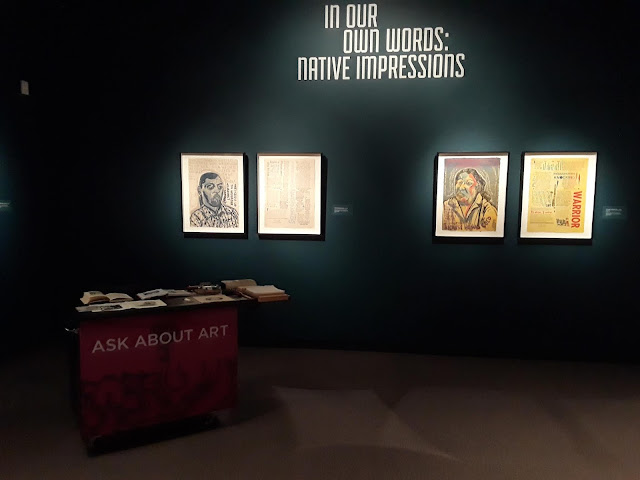Observing, learning, and researching about the human experience through art and education
 |
| In Our Own Words: Native Impressions Exhibition | June 30, 2018–October 7, 2018 |
Hello everyone!
 |
| [Untitled] - Alexander Calder (1898-1976) Amon Carter Museum of American Art |
I absolutely love everything I do at the museum and I wish I could spend more hours there! love both Public and Interpretation programs, I get to do research, come up with ideas for activities, and spending time with visitors. If I have to chose one, it would be Interpretation, which makes me feel weird to chose since I am happy collaborating with both programs.
 |
| Lunar Landscape - Louise Nevelson (1899-1988) Amon Carter Museum of American Art |
Asking "What do you see?" can seem like a simple question, but it is the first step to developing critical thinking skills. I started researching and preparing for my upcoming stories that I'll be reading in front of the "Untitled" mobile by Alexander Calder and the "Lunar Landscape" by Louise Nevelson. I feel really lucky to teach about the two amazing sculptures and read a story to kids. Besides taking notes from my observations of the education staff, I have been revisiting old readings from past Museum Education classes.
While it is a little bit nerve wracking to make sure kids and parents with huge backpacks don't touch the artwork, it is amazing to watch them enjoy the stories and participate in the activity area.The visitors have commented on how much they love the atmosphere of the museum. There is just a great vibe which comes down to people loving what they do. Which brings me to my experience in what I do in the Interpretation program!
There are three new exhibitions right now, the "Multitude Solitude," "In Our Own Words" and "The Theatrical West." There is so much to say about each exhibition, but I will just say that each one challenges the visitor to reflect about our human experience in different ways.
 |
| In Our Own Words and the Theatrical West Exhibitions at the Amon Carter |
There is an area in the "Multitude Solitude" exhibition where visitors can sit and reflect. The question posted is "when did you feel alone?" Some of the answers are positive affirmations about getting through tough times, and others are about people currently going through difficult situations. I was moved by their words in their response about the exhibition and their experience. This speaks volumes about the type of place that the Amon Carter is and again, I am incredibly fortunate to be working there this summer.
Two other programs that I have assisted with are the "Sharing the Past Through Art," a program for people with all stages of Alzheimer’ and "Trivia Night." Two completely different experiences regarding art and memory.
 During "Sharing the Past" I helped setting up chairs, and guiding people to the gallery, I was impressed by the Program manager in the way that she was able to teach about the art in a conversational manner that made the visitors think about their past. The way that Emily managed to speak and be quick to react to what the visitors were responding to is like a super power. I was also very moved, and sad. Their lives were full lives, and memory is who we are. I think about by own grandmother who passed away some years ago and had dementia. If I had known back then that we could have taken her to a program like this, I imagine that she would have benefitted from it. During this event I noticed some of the visitors were excited and participated while others struggled remember where they were and yet they had moments where I saw them smiling at something that someone in the group or Emily had said. Programs like these are so important for them to stay active and sharp, but it's important for us to know, learn and give back.
During "Sharing the Past" I helped setting up chairs, and guiding people to the gallery, I was impressed by the Program manager in the way that she was able to teach about the art in a conversational manner that made the visitors think about their past. The way that Emily managed to speak and be quick to react to what the visitors were responding to is like a super power. I was also very moved, and sad. Their lives were full lives, and memory is who we are. I think about by own grandmother who passed away some years ago and had dementia. If I had known back then that we could have taken her to a program like this, I imagine that she would have benefitted from it. During this event I noticed some of the visitors were excited and participated while others struggled remember where they were and yet they had moments where I saw them smiling at something that someone in the group or Emily had said. Programs like these are so important for them to stay active and sharp, but it's important for us to know, learn and give back.On a lighter note, during Trivia Night, I co-judged the game. It was so much fun, the visitors came in teams of six and they answered questions about general knowledge. The teams were just a fun group of people and spent about an hour and a half looking at artworks and answering some fun and challenging questions. Katlynn and I counted the points and gave prizes to the winners of each round. I learned a few things myself from the questions.
So with all of this experience in such a short amount of time, I am writing for story time and interpretation. Wish me luck!
Until then,
Karla

Comments
Post a Comment